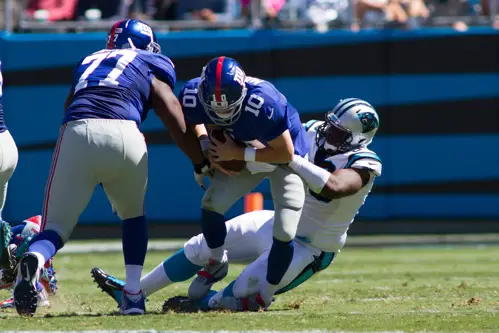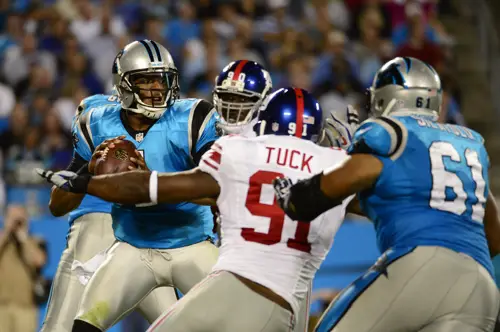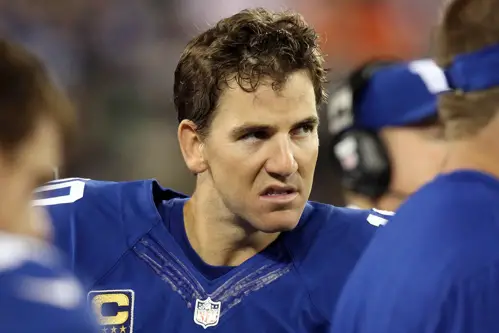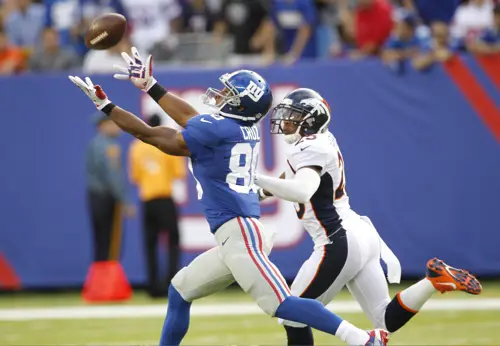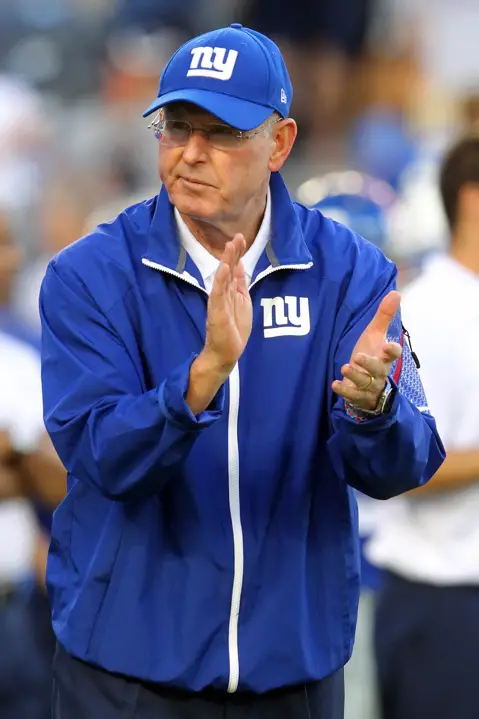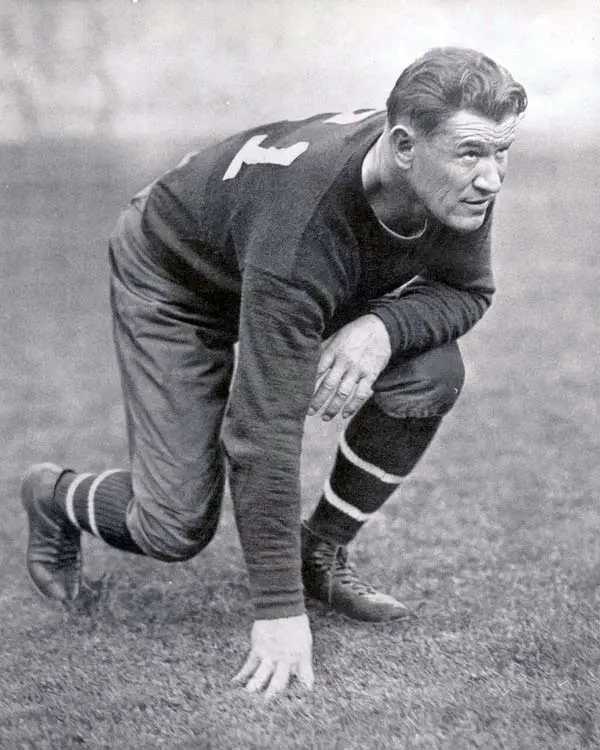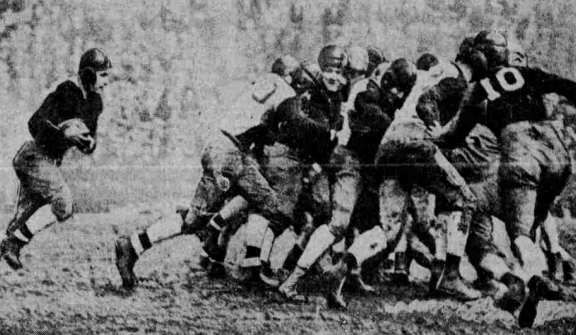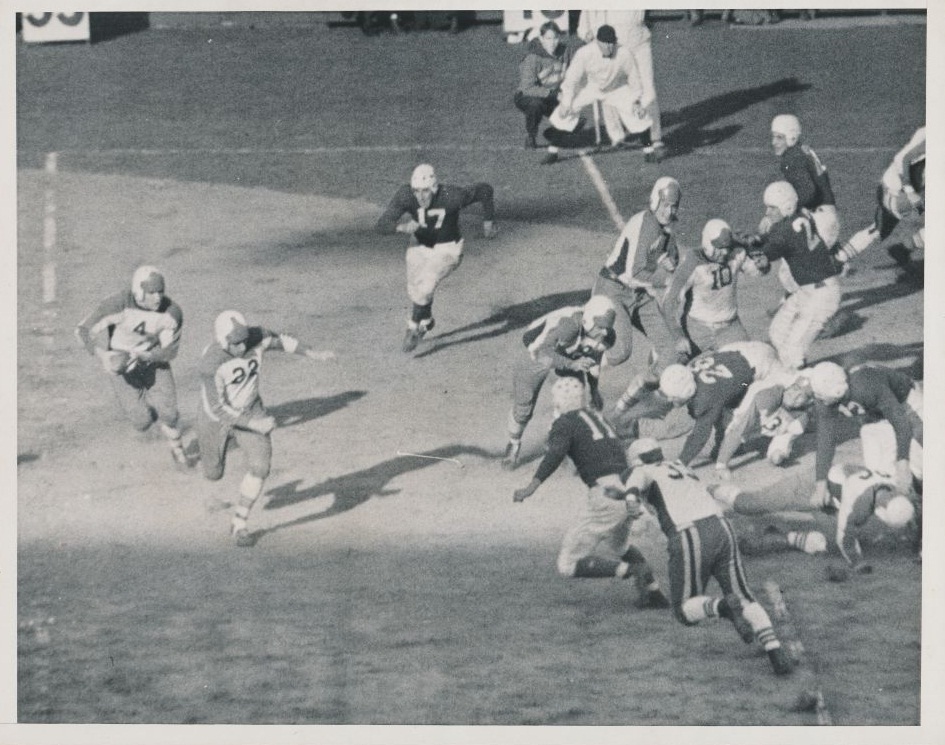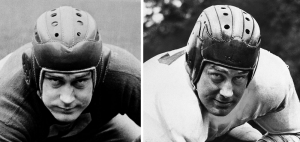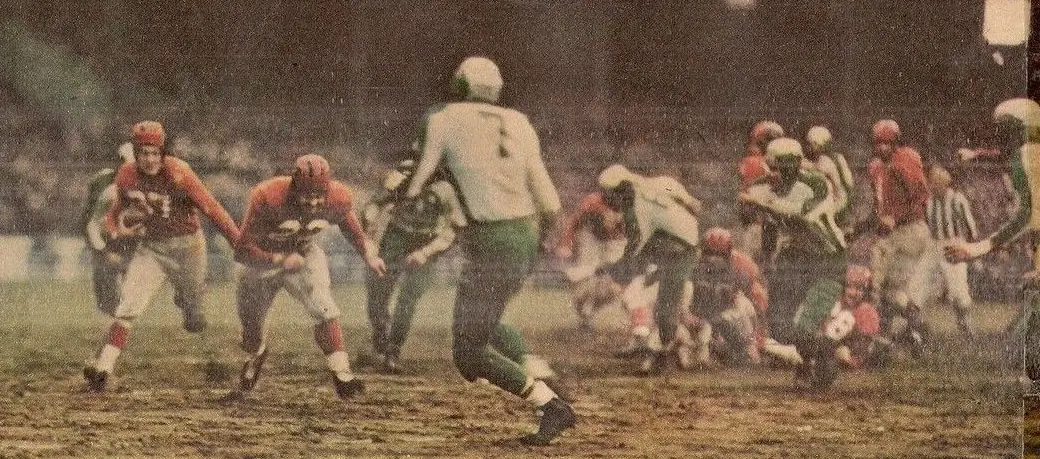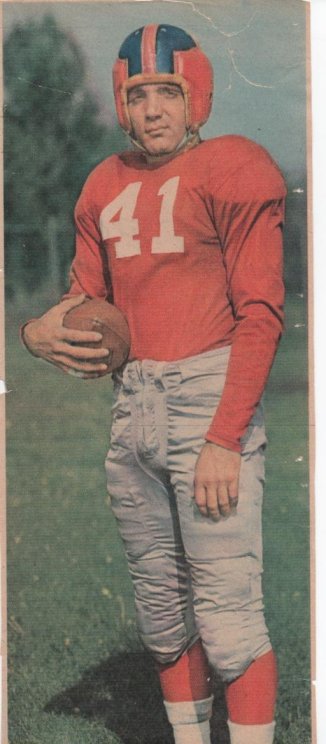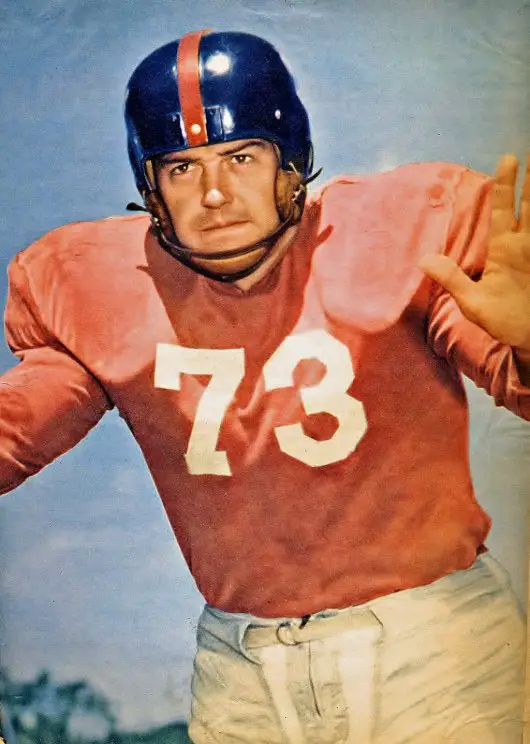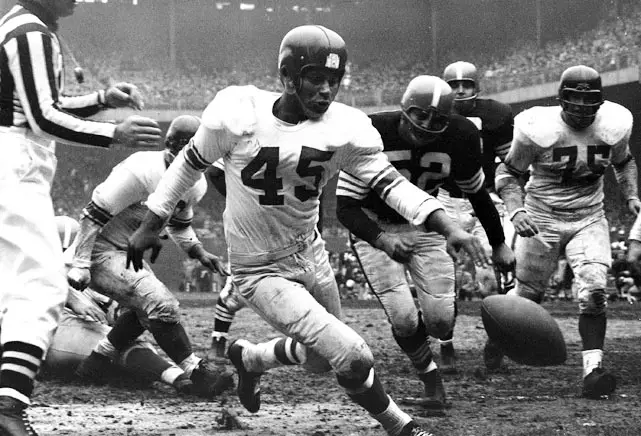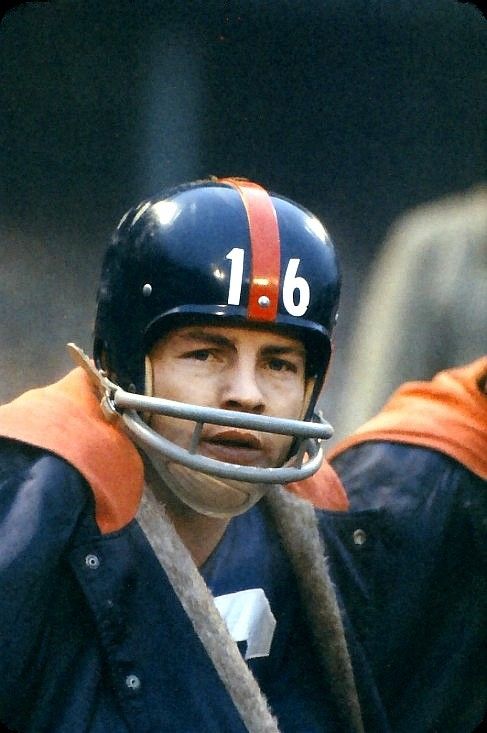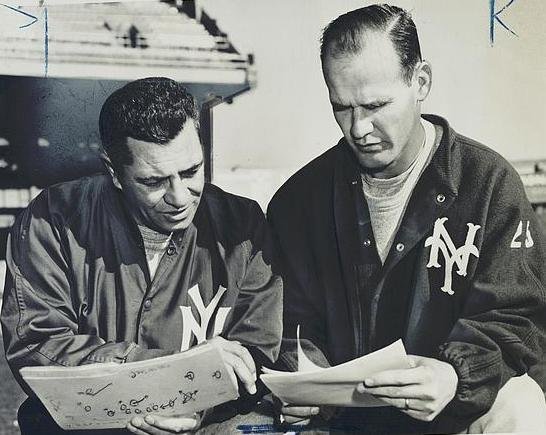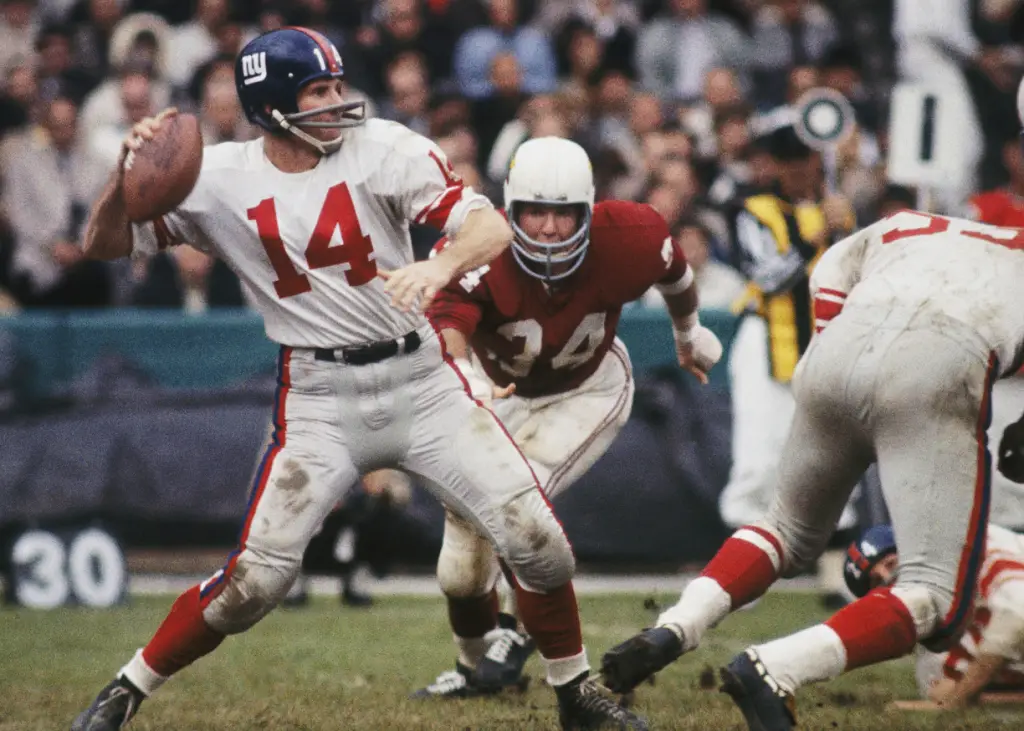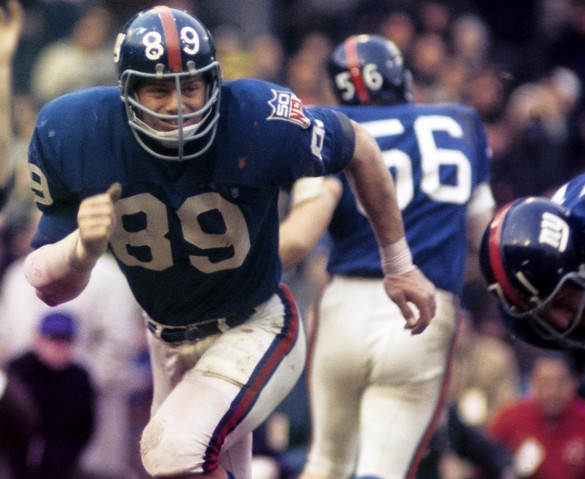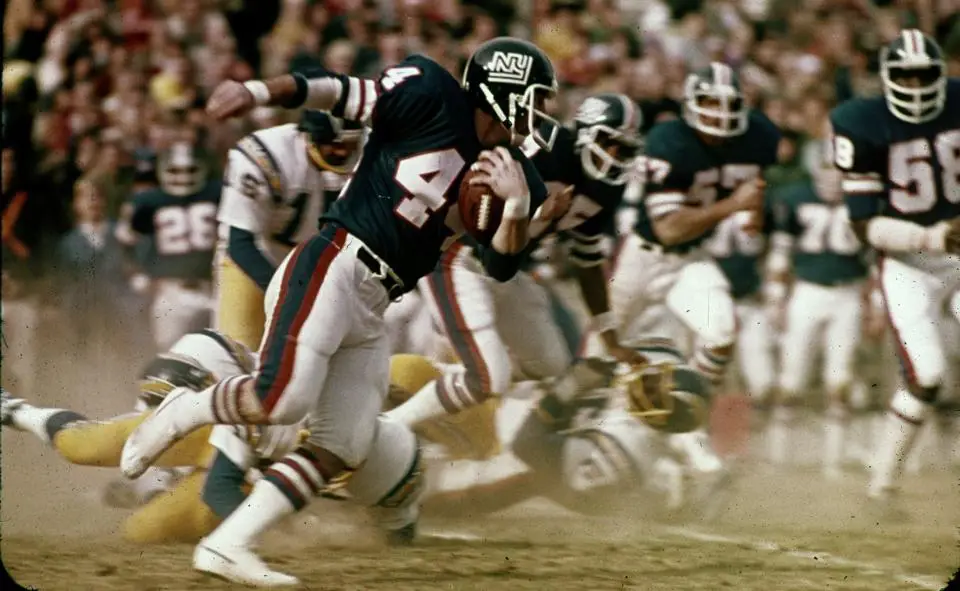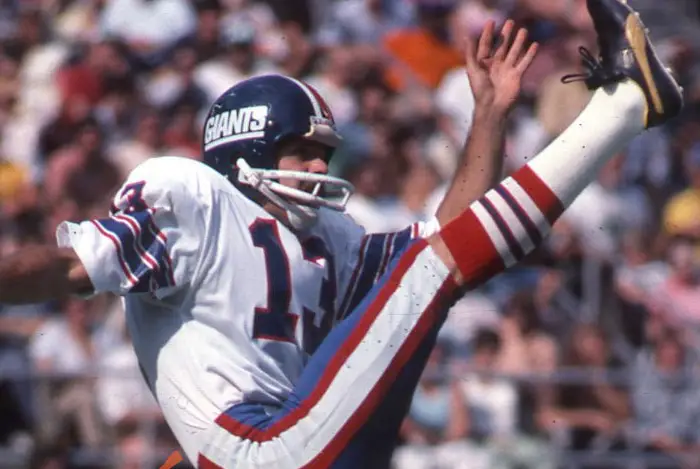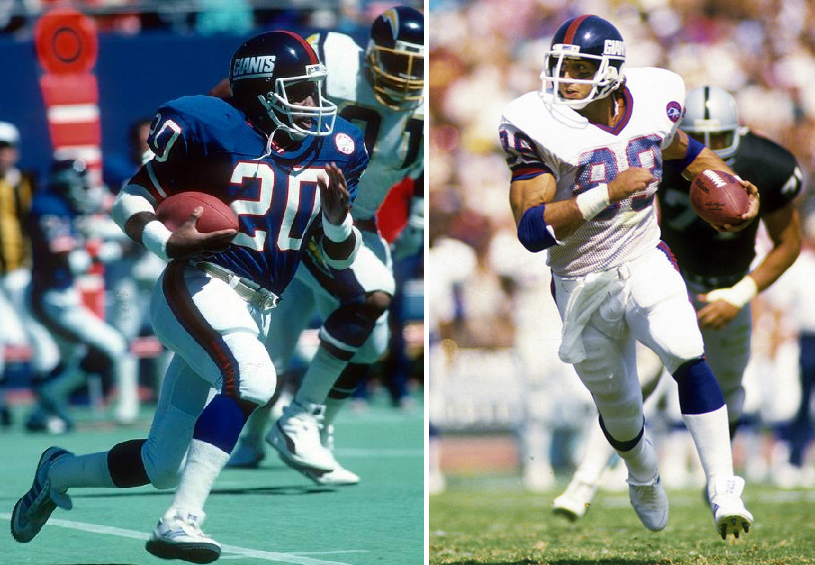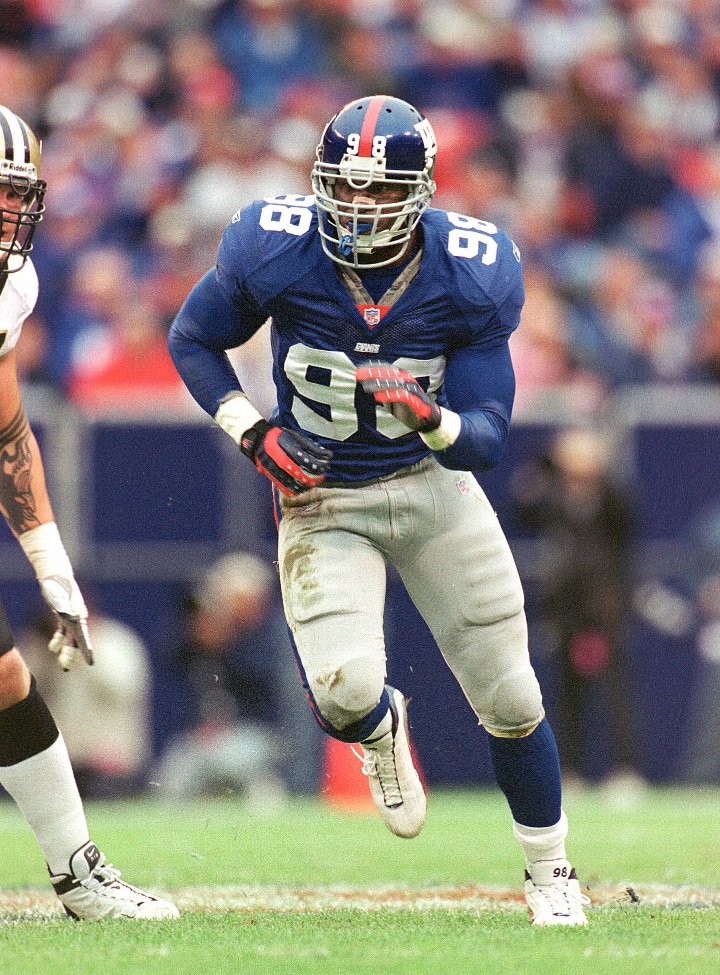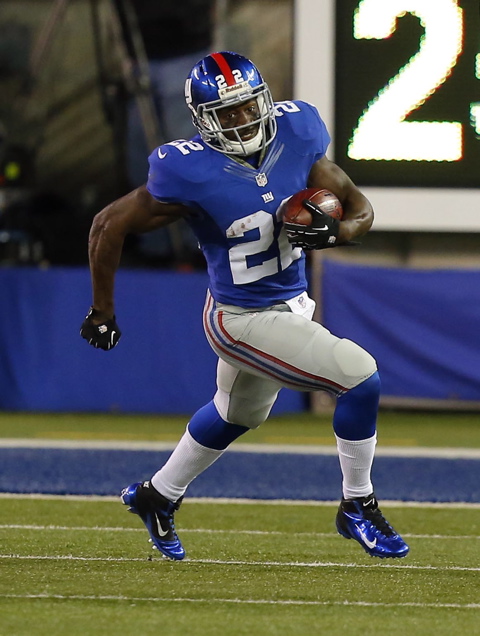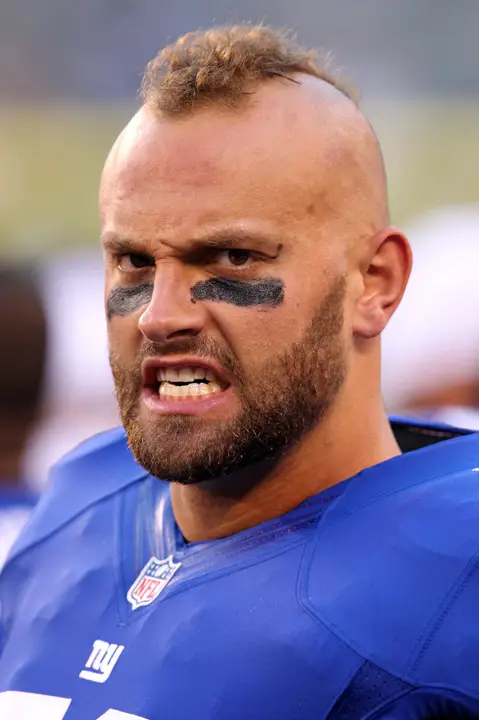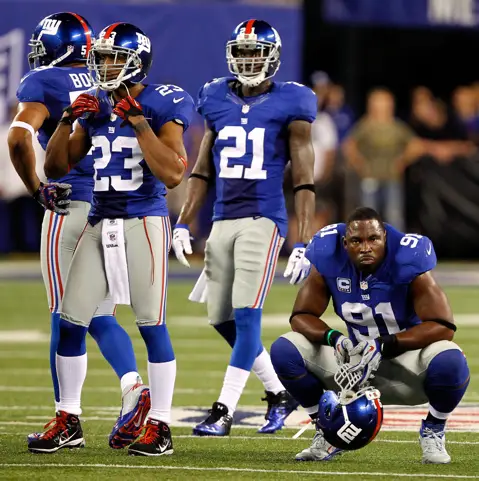New York Giants 2013 NFL Draft Review
Draft Pick Scouting Reports
Rookie Free Agent Scouting Reports
Eric’s Take on the 2013 Draft
2013 Draft Pick Scouting Reports
1st Round – OT/OG Justin Pugh, Syracuse, 6-5, 307lbs, 5.14
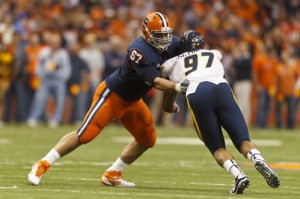
Justin Pugh – © USA TODAY Sports Images
SCOUTING REPORT: Junior entry, but a three-year starter. Pugh has a nice combination of size and athleticism, although he lacks ideal arm length for a tackle. Pugh has the quick feet and fluidity to play left tackle, but he is versatile enough to play any of the five offensive line positions. He is more of a technician and position blocker than mauler, but Pugh is a very good technician with little wasted movement. Consistent and efficient. He plays with very good leverage. Pugh is very solid in pass protection and will surprise defenders with his strong hands. His mobility allows him to effectively block defenders at the second level – Pugh can pull, trap, and block on screen plays. Pugh is extremely smart, competitive, and hardworking. Unlike most rookies, Pugh could press for a starting job right away. He should get bigger and stronger in an NFL training program.
MEDIA Q&A WITH GENERAL MANAGER JERRY REESE: (Video)
Reese: We’ve got offensive tackle (Justin) Pugh from Syracuse, terrific football player. We think he’s really versatile. The Giants, we like guys that can do multiple things. We think this guy can play left tackle, right tackle, either guard, and actually (offensive line coach) Pat Flaherty thought he could even play center. He thought he had that kind of skill set. It’s hard to pass up those kinds of guys, really good football player. People ask about his arm length and that wasn’t an issue for us. We looked at him and when you see guys with 32-inch arms playing the offensive line, especially the tackle the position. I looked at tape after tape after tape and I never could see the arms come into play because I was looking for an excuse to downgrade him but you can never find that. This guy is really productive against the run, against the pass and he was too good of a value. As a matter of fact, he was the highest guy on our board, so we got value and the highest guy on our board. You guys think I’m joking when I say that, but it’s absolutely true, the highest guy on our board.
Q: What position do you think he’s going start out at?
A: I think he’s a tackle. I think he’s going to start out at tackle but I think he is one of those guys during a game that you can plug him in anywhere. He’ll play and he’ll play good for you. Smart, big, smart, high test score, team captain, all those things. Those are the things you like, our kind guy, clean.
Q: Any concerns with the shoulder he had in college?
A: No concerns, our medical staff saw him and they have no concern over the shoulder. He did miss four games early in the season.
Q: Do you think that he can start week 1?
A: We’ll see. I think it’s going to be a lot of competition and that’s what we try to do. We try to create competition and I think he will definitely come in and create competition.
Q: Did you get any calls to move up or move down?
A: There are always some calls and some thoughts about moving up and down. We had some calls to move up, some calls to move down, but nothing really materialized. Nothing really came close to being materialized for us to move.
Q: Did you expect a lot of offensive lineman to be drafted early?
A: Well, there were a lot of good offensive linemen in this draft up there at the top of the draft. Obviously you see them come off the board really quickly. Everybody predicted that this would be an offensive line big boy draft and it kind of held true to form. The big boys came off early.
Q: What do think George Young would think about the pick?
A: George, I’m sure he’d smile about it. George (said) you win with big people. You win with big people and you’ve got to have them. We are going to have another young guy in our offensive line fold that we really like. Again, when people talk about the short arms a little bit I think about Rosie Brown, who was a great player here and Hall of Famer and was a scout for a long time. One thing Rosie said to me one time was that you can never find a perfect player and so he’s not perfect, but he’s a really good football player and we‘re glad to get him.
Q: He’s not a huge guy; can he be a right tackle?
A: Yeah, he can be a right tackle. He played left tackle for them. He’s not a little guy. He’s a big man. He’s a big football player. He’s not little by any stretch of the imagination.
Q: Did you plan on taking an offensive lineman at some point early in the draft?
A: Obviously, we could see that the offensive line is aging a little bit as well, but we go into the draft like always and we look for the best player and we got that combination. We were sitting there at 19, and really sweating it a little bit because those guys were coming off pretty quickly and he came right to us, right where we had him and a good player for us at that spot.
Q: Were you surprised to see Sharrif Floyd drop?
A: Nothing surprises me in the draft. That’s one thing that I learned as young scout, don’t be surprised by anything in the draft so I’m really not surprised.
Q: So the 49ers jumping up really didn’t affect you at all?
A: No, not really. It didn’t affect us, no.
Q: Was there a particular game that you saw that made you think he was a possible draft pick?
A: I watch a lot of tape. I can’t pinpoint a game that I watched but I watched a lot of tape on him though because again I saw the 32-inch arms and I was like ‘I’m going to find something wrong with this guy,’ and there’s nothing wrong with him.
Q: Does it excite you that he seems to be a good run blocker?
A: The thing about him is when I make my notes: productive. This guy is really productive. He’s productive in the run game. He’s technical in the run game. He plays like a high test score. He’s high percentage on pulls, on second blocks, on downfield blocks. You get excited about a guy that brings all that to the table because a lot times when you get offensive lineman they are little bit one-dimensional. This guy is technically sound on all levels. At the point of attack he’s technically sound. He’s got that finish ability that you like in your offensive linemen and in the second level he’s a high percentage getting out on the pulls. He’s a high percentage on the second level in the linebacker area and even downfield he’s a high percentage productive run and pass-blocker.
Q: What’s the one thing that he needs to improve on when you get him in?
A: All young players can get stronger when you bring them into the National Football League. When you start in the offensive line, all young players can get stronger and they do get stronger. They get here and they get in a pro weight program. Their bodies mature a little bit more so they get stronger as they mature as get older in the league.
Q: You said he was “our” kind of player and you also said he was “clean”…
A: Yeah, clean player. He doesn’t really have any warts on him like off-field issues or he’s not a good athlete. He was a clean guy. He had everything you look for. He’s not an aircraft carrier. He’s not that guy but he’s a big solid football player and you win with those kinds of guys. I think you win with solid football players. We’ve won a couple Super Bowls with David Diehl, a solid football player, with Kareem McKenzie on the other side, a solid football player. You win with those kinds of guys, our kind of guys.
Q: Could you have waited until a later round to take a solid player?
A: It is hard to wait when a guy is sitting right there – the highest guy on your board. We always try to wait a few minutes and see if somebody wants to come up there and knock us over with a trade that we can’t refuse. We always do that. But he was sitting right there so there really wasn’t a lot to wait for with respect to him.
Q: Was he the last offensive lineman in your first round?
A: I can’t tell you that but he was – along with some of the guys that got picked ahead of him – he was right in the pack with those guys.
Q: How much time did you spend with him pre-draft?
A: Same amount of time as we spent with all of them. It is not a significant amount of time. You have heard this from me before – you don’t have to spend a lot of time with guys that are clean. Those guys – clean guys – there really wasn’t a lot to spend time with him for. We did spend some time with him but there wasn’t a lot of digging that we had to do with this player.
Q: You said “32-inch arms” – what should a lineman’s arms be?
A: Well, it depends. If you play inside, if you play center, if you play guard you could have shorter arms; you have shorter arm length. People like for your tackles to have longer arms. When you start talking about 33-inch arms it is really what I think about when I think about arms being long enough on the outside. I think about 33 inches. And so you are talking about this much. But it is just the way it is. We have our standards – what we like – and again, Rosie said there was not perfect player. He is not perfect. If there is anything wrong with him, that is it. But again, I looked at a lot of tape and wanted to see his short arms come into play – I never did; I never did.
Q: What do you see in the second round?
A: It will be interesting. With the draft you see players – the value seems to be similar in a lot of different positions. So you will see players coming out all over the board. We think we will get — there are still a lot of good players left on the board. We think we will get a couple of more really good players to come in and contribute for us right away. And we will get guys in the fourth and fifth round as well that we hope can hit on some guys in those rows. But there are still a lot of good players up there.
Q: What is the next position you plan to address in round two?
A: A good football player – that is what we would like to address; good football player.
MEDIA Q&A WITH DIRECTOR OF COLLEGE SCOUTING MARC ROSS: (Video)
Q: What were your general impressions of Justin Pugh?
A: Justin just is, I’m sure Coach and Jerry have said, is clean – is just a clean player. For us that means he was productive on tape, he plays hard, he’s smart, he’s athletic, he’s physical, he’s a great kid, he doesn’t have any issues and he has a lot of upside. When you go down the checklist of positives that you look for, he had most of those attributes.
Q: Did you think some of the tackles that were taken earlier in the draft were going to be available at 19?
A: No, we thought pretty much that some of those guys were going to go quick, that the four who went were going to go pretty much where they did, and even the guards.
Q: Is it a strength that he can play a number of positions?
A: For us, I think he has the skill set to play anywhere along the line, and whatever our coaches feel is the biggest need to put him at next year, I think he can do that – from left tackle to center to right tackle to guard, he really has… because he’s so smart, so technique-sound and so athletic, it’s definitely a positive to be able to do that.
Q: Do you normally see a guy like that go in the first round?
A: No. Most of these guys are what they are – they’re a right tackle, they’re a center. This guy is the most versatile offensive lineman in our eyes. Other teams may feel differently, but that’s the way we felt, that he was the most versatile.
Q: Why did you like this kind of player?
A: Because in a year who knows what our needs will be. Just having a guy that even during a game, if your center goes down, he can go in there and move wherever you want him to go. And there’s nothing wrong with having a top notch left tackle, if that’s what he is. This just added to it. This isn’t the only reason why we liked it. It just added to him.
Q: Jerry Reese said he needs to get stronger, but there are a lot of players like him. Is there a goal in mind?
A: That’s up to our strength coaches once they get here. And he was coming off a shoulder injury earlier in the year. He missed the first four games. We don’t think this year was a true indication. He kept getting better, getting stronger throughout the year and into his whole career, I think his body will fill out more and get stronger once he can fully workout with the shoulder. But even in today’s game, those top tackles that got taken, power’s not really their game. (D.J.) Fluker was the power guy, but those other guys were more athletic types of tackles.
Q: What makes you confident that he can play multiple positions?
A: He did it at the Senior Bowl. He played a bunch of different positions at practice and during the game. And then his intelligence, he had one of the higher test scores this year. Just talking to him, communicating with him at the Combine, it will be an easy transition for him.
MEDIA Q&A WITH HEAD COACH TOM COUGHLIN: (Video)
Coughlin: We are excited about this pick. We had an opportunity throughout the course of our meetings here to sort of analyze the players that we thought would be available to us at this particular spot in the draft if something didn’t happen to shock us out of that position. There was a run on the tackles early, as you know. It kind of backed off – Fluker was taken and then it kind of backed it. There was a trade right in front of us. We didn’t think San Francisco would take an offensive lineman. We didn’t know for sure, but we didn’t think so. And so in the group of players that we really liked that we hoped would be available to us at 19, we had this young man right at the top – Justin was the guy on the board who was on top. So we are real happy to get him. I have been asked, ‘Do you think it is time for you to take a hard look at your offensive line in terms of young talent?’ Well, there always is. Some years it is just not available to you. So we do feel like the addition of some young talented players in our offensive line is going to help us going forward in the future. We think we have a young man who has demonstrated the ability to learn. He is a very technically sound player. He has performed at the left tackle position. We think he can play right tackle. We have even talked about the versatility that he presents because he has big hands and perhaps he is even a guy that could be considered as a center if we thought we needed that. So versatility – smart – technically sound – a guy that we think can grasp the system right away and be in a position to help us out as a young player in a position that is not easy to play right away. And that is the offensive line at the professional level.
Q: Would you like him to wind up on day one at right tackle?
A: Well, that is probably what will happen. But we will look at the rest of the draft and see what happens to come our way. And at the end of that we will assess our depth and see where we think we should start him out. He has been a tackle. I would expect him to stay there. Whether he goes over to the right side or not, and how fast he goes over there – we will have to decide.
Q: Could he be an opening day starter?
A: I’m sure that competitively he will have that opportunity. If he wins the job, then he would be the starter.
Q: You and others in the organization talked a lot this offseason about fortifying the trenches on both sides of the line.
A: Very important.
Q: How big a priority…top of your list?
A: Well, it certainly was a strong consideration. I have always believed that if you are strong in the offensive and the defensive lines, you have a great chance to be competitive. And this is certainly consistent with that theory. We have got good young players here that are going to compete. We have veteran leadership here as well. It is a good situation to be in. Let’s let them compete. As best we can, we would like to be competitive and have challenges at all positions. As more competition as we can place, no matter what the position is, the better off as a team we are going to be.
Q: Did you have a chance to talk to him?
A: I did.
Q: What impressed you about him?
A: His first answer; the first question he was asked.
Q: Which was?
A: ‘Who is the Syracuse alum that you are most familiar with?’ He didn’t say Jim Brown, he said ‘Coughlin.’ He passed the IQ test right away at the Combine. That was a Marc Ross (question) – you knew that was coming when Marc took the floor. I knew something was coming.
Q: Was his run blocking what jumped out at you in watching the Syracuse offense?
A: Run and pass. We certainly saw the bowl game in which they did a tremendous job of rushing the ball. But there have been numerous games where that good young quarterback up there had big days as well. So we have been able to see Justin as a pass protector and as a run blocker and have been equally impressed.
Q: The way the defense struggled last year, was it hard to go with an offensive player with your first pick?
A: It wasn’t hard, but if you know the way that we conduct our business, it is going to be the best player. You may think that there is a need – a greater need somewhere else – but the history of this organization has always been as far back as you can remember, take the best available player. And I think that was consistent with the first pick of the 2013 Draft.
MEDIA Q&A WITH JUSTIN PUGH:
Q: What was it like when you first got the call from the Giants telling you that they were going to select you?
A: It was surreal. This has been a dream of mine since I was a kid playing tackle football in my backyard. I got the phone call and there was about four minutes left on the clock. I saw that 201 number and knew who it was. I turned the TV down, I got a big smile on my face and it was crazy. Coach Coughlin was like ‘Welcome to the Giants.’ It was amazing.
Q: The Giants said they really liked your versatility. Would you be comfortable moving to right tackle after playing left tackle as a starter?
A: The biggest thing the coaches have told me and I’ve tried to present to teams is I can play all five offensive line positions. Coming in, I’m just going to compete wherever they want me to. I think I can play all five positions on the offensive line. I really just want to come in and show what I’ve got. I know coach has said that he likes my versatility and my football smarts so I’m definitely ready to get in there in minicamp next week and start competing.
Q: Did you have a lot of contact with the Giants before the draft?
A: I talked to these guys at the Combine but never had a private workout. I had a decent amount of contact but not as much as with some of the other teams. It wasn’t a surprise. I kind of heard that they liked me at that spot. It was awesome to get that call. Obviously with Coach Coughlin being a Syracuse guy, that makes it even better.
Q: Do you think you could be a starter as a rookie?
A: Yes. I think I can come in and compete. I’m confident in my abilities to start but also, at the same time, whatever the coaches want me to do, I’m willing to do and take on that role happily.
Q: They said at the Combine, the first question you were asked was about the most notable Syracuse alum you knew…
A: Yeah, the first thing that came out of my mouth was Coach Coughlin. Everybody started laughing and they said, ‘Welcome to the New York Giants.’ I guess I should have seen that as a little bit of a sign that they might be targeting me. So I guess it turned out real well. As soon as I got the phone call, my stepdad said ‘it was a good thing you answered that question the way you did because obviously it got them very interested in you.’
Q: RE: Shoulder Injury
A: My shoulder is 100%. Obviously, I came back and played in the last nine games, was All-Conference and played in our bowl game. I did 225 (lbs) 22 times, which is what I was at before (the injury). Obviously, I’m working on getting stronger, I did more reps since that, I’ve done 24. So my shoulder is a 100%, no worries there.
Q: With six offensive linemen going early, did you start to wonder if you were going to go in the first round?
A: When you see six offensive linemen get taken, obviously it shows the depth of the tackle class this year, the offensive line in general. So I knew there was a possibility that I would be the next offensive lineman/tackle off the board. You never want to get too overconfident because football has a way of humbling you. I was getting nervous as every pick went by, saying ‘is this going to be the one?’ I saw that 201 area code and my buddy is right from that area, so I knew it was from the Giants.
A: Are you a fan of the Giants by any chance?
A: I grew up in Philadelphia as an Eagles fan, but last year I told myself, I’m not a fan of anyone else anymore, whomever I’m going to, I’m going to become a fan of that organization. I’m a fan of winning, so I’m ready to get there and compete and win.
Back to Top
2nd Round – DT Johnathan Hankins, Ohio State, 6-3, 320lbs, 5.31
SCOUTING REPORT: Junior entry, but a two-year starter. Hankins is a big, strong, run-stuffing defensive tackle with good athletic ability and agility for his size. He is a better run defender than pass rusher. Hankins is very stout at the point-of-attack and can take on double-team blocks. When he plays with leverage and proper technique, Hankins is very difficult to move off of the line of scrimmage. Hankins also has the athletic ability to pursue down the line and will flash occasionally on the pass rush with quickness and power. He has good lateral agility and even dropped into coverage at times in college. The biggest knock on Hankins is his inconsistency. At times, he dominated in college; at other times, he disappeared from the action. However, he played a lot of snaps in each game and wore down. He should perform more consistently in a rotation and with better conditioning. When not out of gas, Hankins plays hard. Hankins has the tools (size, strength, power, quickness) to excel at the NFL level if he wants it badly enough.
MEDIA Q&A WITH GENERAL MANAGER JERRY REESE: (Video)
Reese: We’ve got two defensive linemen, we’ve got a defensive tackle and a defensive end. Two really good football players. We’ve got a big guy that can hold the point inside, tough against the run game – big bodies. Both of these kids are really young players, so you like that about them. Big Hank is just a powerful inside presence, played a lot of snaps. They played him a lot. You like that about him that he can have the stamina to stay and play. That probably affected his game a little bit on the back end because I think he ran out of gas sometimes when we watched him, but early on when he gets going, he’s a tremendous inside big thick young player against the run game and against the pass. I wouldn’t call him a pass rusher but he gets some pressure up the middle. He can push the pocket up the middle. He can snap some heads back with his initial contact so he can push that pocket back. We think he can be a great addition, a young player. The defensive end (Damontre Moore), he is sacks. When you think about him, he’s a young kid, he’s 20 years old. In three years he got almost 26 ½ sacks, 26 ½ sacks is what he’s got, had 12 ½ this past season, I believe. He’s an edge rusher, tremendous upside for us- too good a value for us to pass up.
Q: Was it a goal in this draft to get bigger and better in the trenches?
A: Well, that’s always a goal. Again, if you don’t have bigs it’s so hard to win up here, so the more bigs you have it gives you the opportunity to win football games.
MEDIA Q&A WITH DIRECTOR OF COLLEGE SCOUTING MARC ROSS: (Video)
Q: Tell us about Johnathan
A: Johnathan is a big, wide-bodied space-eater on his side. He is young. He is 21 years old. He has a lot of upside. He is not a glamorous type of guy inside but he does the dirty work that you need in there to occupy people – hold the point. He is a powerful upper body – snatch blocker for a 320-pound guy. Plus he plays the whole game, which you rarely see. You see most of these defensive tackles – defensive linemen – rotate in and out every series. This guy plays the whole game and plays with energy. He has got enthusiasm for the game. He is only going to get better.
Q: Coach Coughlin has mentioned that a priority this offseason was getting better on the run defense. Was this guy a person you targeted as the person who would be a force in improving that area?
A: Yeah, to us his skill set was real easy to identify. You watch him play and that is what he does. He just shuts people down when they try to run the ball. Whether it is taking on one block, two blocks – he just bangs inside and he holds the point. You need those guys to win. It helps everybody on your defense. It helps your linebackers get free. So we really like that about him. And you don’t see that much anymore with the types of defensive tackles that are coming out. You see more of the athletic, quick edge, movement-type of guys. So this guy is kind of a rarity nowadays where just somebody that does that dirty work in a big body inside. And he likes it.
Q: How are his arms?
A: He could give a couple of inches to Pugh. They balance out each other – they will play off each other well.
Q: How big is he?
A: He is wide…He is just wide. He is just wide. He is about 6-3, 320 pounds. He probably played over that during the year. But he got into shape obviously throughout the postseason – all of the training. So, yeah, he is a wide body. When we use that expression, he is that.
Q: Is that where you want him – 320?
A: He probably could lose a few pounds. He is young, so he is still growing into it. He probably hasn’t had as much of full-time training and conditioning and nutrition that he will get up here. And he is only going to get better – he will grow into his body. He will become more of a man and shed some pounds and the sky is the limit for him.
Q: As young as he is, is he polished enough to be a starter?
A: Yeah, he has played a lot of football at Ohio State. He started and he plays with good technique. He plays with good hand use. He plays with good leverage. He has got really good awareness inside to find the ball – recognize blocking schemes. So this is not just a raw guy that doesn’t know what he is doing. This guy knows how to play football. And he has played a lot of it and started a lot of it at the highest level.
Q: Does he kind of compliment Linval (Joseph) and (Cullen) Jenkins?
A: Right – you like a blend inside there. You would like a defensive tackle that is big and athletic and fast and can do everything. But that is just not the reality nowadays. A guy is either one or the other. And so this is a big, wide-bodied presence inside.
Q: What would you say is the knock on him? Mike Mayock said he has first round talent so he slips to the second round – good for you if that is where you wanted to get him anyway. But why do you think he might have slipped?
A: We had him identified as a first round guy. Some people might have been scared off by his lack of sack production. He just had one. Some people might have questions regarding his stamina. Okay, the guy is 320 pounds and he plays every snap, like I said earlier. So if he wears downs at the end of a 60-play game, I could understand that. So you have to look at his body of work. You have to dig deep into who he is. The kid is a great kid. He loves football. He is going to work his butt off. So those concerns that others might have, we didn’t have.
Q: He is a three-down player?
A: Yeah. He has to develop his pass rush. That wasn’t his strength as a pass rusher. Right now we would throw him in there as a two-down run stopper and develop his pass rush.
Q: You wanted to get bigger – last year you picked up Shaun Rogers. This year you brought in Hankins.
A: You always want big bodies. You have to win with big bodies in this league. It starts up front on both sides of the ball. We think we have done a good job with that – with our first two picks. We will see what happens the rest of the draft. But we wanted to get bigger, more physical up front, and we really think we have done that with these first two.
MEDIA Q&A WITH HEAD COACH TOM COUGHLIN: (Video)
Coughlin: Two defensive players today to help our defense – take care of the front. Run stopper in Hankins, a young kid. They are both young; one being primarily a defensive tackle that has outstanding first and second-down run-stopping ability. The other kid, Damontre Moore, has great production – 12 ½ sacks – 26 ½ over his career, 21 TFL’s; a very, very good effort player on Saturday. He has some issues, I think, during the week, which we will have to address in terms of preparation and practice mentality, that type of thing. But he is young, just 20 years old. Hankins just turned 21. So we have three young guys in the fold – an offensive lineman, a defensive tackle and a defensive end. And so at the end of the day we feel good about where we are.
Q: What about last year’s performance by the defensive line…?
A: Well, you have to continue to build. We were 31st in the league on defense. I think that is enough said.
Q: This is like a return to old time football – big bodies up front.
A: Like to. Yeah, for us – for me – I’ll speak just for me – that is where it starts – up front. And you have to continue to develop and build. Be strong up there – competitive. We have good players here. We have just added some players to the mix and hopefully the competition will make our team better.
Q: You see other trends going – teams going in a different direction – small players up front. Why, for you, is it important to stick with the big guys up front?
A: Well, we are in the NFC East. We do have two teams now – one of which has established itself as running the option. However, if you look at their offense, the plays that hurt you the most are the power-type plays – the dive, the zone run, and of course when the quarterback keeps the football. In Philadelphia that will change a little bit as well. But we still have Dallas and the Giants in this division that are primarily the run game that we have to come to acknowledge here as the professional football running game. We don’t run the quarterback – at least we try not to – and leave the running game to the front and the runners.
Q: Last year there were some issues on defense at linebacker and the secondary. Do you think addressing up front helps take care of some of these issues?
A: That is what has presented itself right now. We know it doesn’t take care of your linebacker issues; it doesn’t take care of your secondary issues. But if we can do a better job of stopping the run, those two areas will be naturally affected in a positive way. But we have addressed what we can. We have had three picks and the three picks have been represented by linemen. So that is a good thing. So where can we go and what can we do to continue to invest in some new talent; some competitive players that can come in and challenge, so we’ll see throughout the rest of the draft and what is left of free agency.
Q: Are these two guys polished enough to be able to make immediate contributions?
A: Basically they have to. You have to bring them in and they have a lot to learn. They have to understand principles and values and how you do things. They are young but the nature of the business in the game today is they have to help us.
MEDIA Q&A WITH JOHNATHAN HANKINS: (Video – Giants.com Interview)
Q: What were you anticipating tonight?
A: I was just anticipating hearing my name get called on TV. I’ve been working hard for this moment and all my family and my support – my coaches. I felt like this was a good pick for me and I’m ready to work hard and keep going.
Q: Did you know the Giants were interested?
A: Yeah, I knew they had a little interest in me and I talked to them a couple times but it was just so much building up to this moment. Just to get that call from the New York Giants and just be able to play for them and the history they have of winning championships. I’m ready to come along and help as much as I can.
Q: Can you rush the passer?
A: I feel like I can rush the passer. One of my strong points is stopping the run so I’m working on my pass rushing techniques. I’m working on getting that a lot better so I can be a complete D-tackle.
Q: What did the Giants talk to you about?
A: They basically talked to me about coming in and contributing to the defense and doing the best that I can and hopefully be a starter one day but just come in and make a good impression and help the team out.
Q: How did your career at Ohio State prepare you to play in the NFL?
A: It helped tremendously well from just my physical aspect with my weight and getting me stronger. Then when it comes to the game, just watching film and knowing what the offense is going to do before the play even happens and just the tradition there just getting guys to the league was just a great asset for me and they prepared me really well.
Q: Have you compared yourself to DT Shaun Rogers?
A: We have a nice comparison. He’s a dominant defensive tackle in the league. Playing, I feel like we both have kind of a sort of a similarity to our game but I’m going to learn from him and try to get better.
Q: Do you see yourself as a rarity as a player?
A: Yes, I see that. I feel like being the way I am, 325 pounds. You don’t really see too many big guys running from sideline to sideline making plays. Just playing defensive end and all of the positions on the defensive front, I feel like I’m probably one of the best and I feel like I’m the best so I’m going to keep working hard to help the team be good.
Q: How many plays were you on the field for in a college game?
A: I basically this past season played the whole game. With Coach Meyer, he never wanted his starters off the field so that’s one thing while I was getting ready for the offseason I was trying to get in better shape because I knew I wasn’t going to be able to come off the field. Plus, I love the game. I really don’t want to come off the field so I took the challenge of playing all of those snaps and I feel like I did pretty well at it.
Q: Did you think you had a chance to go in the first round?
A: It was a chance but things happen. Some teams saw who they wanted and who they wanted to pick but right now I’m just happy and blessed that I get the opportunity to play right now.
Q: Where are you right now, are you with your family?
A: Yeah, I’m with my family back home in Detroit.
Q: Are you able to come to the rookie minicamp?
A: Yeah, I think I’ll be there for the rookie camp.
Q: I assume you grew up a Lions fan?
A: Not really, I was really a defensive guy. I liked teams with good defense. I liked to watch the Patriots and the Steelers. I’m just more of a football player, not just a fan of a single team.
Back to Top
3rd Round – DE Damontre Moore, Texas A&M, 6-4, 250lbs, 4.95
SCOUTING REPORT: Junior entry, but a two-year starter. Moore lacks ideal size and timed speed, but he is an athletic disruptor who plays hard and makes a lot of plays in the backfield. He has good first-step quickness, agility, and change-of-direction skills. Moore has very long arms. Moore is a better pass rusher than run defender. Relentless getting after the quarterback, but he can be handled at the point-of-attack on running plays. He needs to get stronger and add some bulk – still growing into his body. He tested and interviewed very poorly at the NFL Combine, but the production was there on gameday. Moore has some character concerns, including a drug possession charge. He needs to improve his off-the-field work ethic and commitment to the game. Moore has the tools to become a very good player if he wants it.
MEDIA Q&A WITH GENERAL MANAGER JERRY REESE: (Video)
Reese: We’ve got two defensive linemen, we’ve got a defensive tackle and a defensive end. Two really good football players. We’ve got a big guy that can hold the point inside, tough against the run game –big bodies. Both of these kids are really young players, so you like that about them. Big Hank is just a powerful inside presence, played a lot of snaps. They played him a lot. You like that about him that he can have the stamina to stay and play. That probably affected his game a little bit on the back end because I think he ran out of gas sometimes when we watched him, but early on when he gets going, he’s a tremendous inside big thick young player against the run game and against the pass. I wouldn’t call him a pass rusher but he gets some pressure up the middle. He can push the pocket up the middle. He can snap some heads back with his initial contact so he can push that pocket back. We think he can be a great addition, a young player. The defensive end (Damontre Moore), he is sacks. When you think about him, he’s a young kid, he’s 20 years old. In three years he got almost 26 ½ sacks, 26 ½ sacks is what he’s got, had 12 ½ this past season, I believe. He’s an edge rusher, tremendous upside for us- too good a value for us to pass up.
Q: Why did Moore slip to the Third Round?
A: I’m not sure because early on people had him ranked pretty high. You listen to the people who rank college players and he was ranked pretty high. We were a little surprised he was up there that long with his sack production, but you can’t pass guys with that kind of sack production so it was a decision we made to go and go get him right there with that pick.
Q: Is his history with marijuana a concern at all?
A: Well, we’re always concerned if that’s an issue with players. We do extensive background information, get extensive background information. I think that it’s a situation where we can handle that. His off-field issues, which I don’t think are significant, I think that we can handle. If he has any issues, I think that we can handle it.
Q: Does the youth of Damontre Moore make him a project?
A: It makes him a kid that has a lot to learn. He’s got a tremendous upside. He plays three years, he’s a junior, so he can come in here with (Defensive Line Coach) Robert Nunn, who does a tremendous job with our defensive line. He’ll learn a lot right way. He’s one of those kids that can play on your special teams. He’s got a pretty unique skill set.
Q: Will Damontre Moore play exclusively on the defensive line?
A: I think he’s probably going to be penciled in as a defensive end and again all young players we get that can run; they play on special teams for us as well.
Q: Do you think a guy like Moore has the ability to step in as a rookie and be a situational pass rusher?
A: We hope so. It’ll create some competition. It’s going to be great competition all over our football team and I love that because it only makes your football team better when you have competition at a lot of different positions- we will have that. We will definitely have that.
Q: With Moore’s measurable, is there any comparison to DE Mathias Kiwanuka ?
A: He was 260 at his Pro Day so he’s a little bit heavy and again he’s 20 years old, so guys mature, their bodies mature, and they’ll get stronger. He’s already gained 10 pounds since the Combine. I think Kiwi is a bigger frame. Their lower body is probably similar but obviously Kiwi has been around for a while. He’s definitely matured and filled out, but there could be comparisons drawn if you look at their lower body. Yeah, that’s not a bad comparison.
Q: Did he play some linebacker during his college career?
A: Not a lot, I don’t think he played a lot of that linebacker stuff. When you see him a lot of times, they do rush him inside a lot but he’s off the edge most of the time. The thing I like, he plays hard. Guys that play hard, you can coach them to do the rest because this guy plays hard. He plays with a nasty streak and we think he’s got a tremendous upside.
MEDIA Q&A WITH DIRECTOR OF COLLEGE SCOUTING MARC ROSS: (Video)
Ross: Highly productive, well that’s the first thing. The guy’s production is off the charts when you compare him to people who got picked ahead of him at his position. Just look at the stats. In our view, the things we liked, we think good NFL players were good college players; productive NFL players were productive college players, and this guy epitomizes that. He’s only 20 years old. He has a world of talent. He’s athletic. He plays hard. A little bit leaner body frame, he has to grow into his body. He has 35-inch arms. He’s physical at the point of attack with the upper body. Tons of upside, but this guy, he’s a football player who makes plays.
Q: How good is he against the run?
A: He’s good. Right now with his body, the lower-body stoutness needs some development but he’s powerful and strong in his upper body using his arm length to snatch guys. When he gets his hands on guys, he can really control them. He does get swallowed up some if they get on him but if he gets his arms on people, he’s hard to handle and he’s really athletic in space. He makes plays all the way down the field and in the backfield. You look at his tackle for loss production and it’s amazing. So he’s really athletic once he gets in the backfield.
Q: Sacking ability is a highly coveted skill. Why did he last so long if that is one of his strongest traits?
A: Some people may have gotten scared off at the Combine when he ran so slow and didn’t lift that well. A Terrell Suggs, a Trent Cole, a Derrick Burgess ran really slow but played fast on tape; things off the field that people may not have been comfortable with where he just needs to grow up. He’s only 20. He needs to be a professional a little bit. He’s a good kid who loves to play. Those may have been a couple of reasons.
Q: Did he interview okay at the Combine?
A: Yes, he interviewed okay for us. But when you see a guy run 4.9 when guys are running 4.5s and 4.6s, people jump all over that number as opposed to the 12.5 sacks and 21 tackles for loss numbers.
Q: Did you target him as a guy who might fall because of these issues?
A: Yes. We felt good that he wasn’t going to be a first round pick. I thought he might go at the end of two, so we had him in a good spot. But, again, nothing surprises you in the draft. You have to be prepared for everything. You have to stack your board for how you like the players. We were glad he was there. He was too good to pass up at that point.
Q: Is he strictly a defensive end?
A: No. He stands up there and does everything for them. They (Texas A&M) had a special joker role for him, they kind of called it there. He had his hand on the ground, he stood up. Our coaches are excited to use him in different ways. You’ve seen some of our guys do that hybrid role. Kiwi’s been up and down. He has a skill set to do a little bit of both. But he won’t be strictly a linebacker for us. It’ll be more of a hybrid role.
Q: Who does he remind you of?
A: Damontre Moore. He has his own type of unique skill set. He’s athletic, has really long arms, can bend. He’s explosive with his closing burst—nobody who I can say… When I watched him, it didn’t jump out that he reminded me of anybody. He was pretty unique.
Q: He didn’t lift or run well, so what made you like him?
A: Twelve and a half (sacks) and 21 (tackle for losses).
Q: Then why test him?
A: That’s a good question. That’s a good question. At the Combine you have to do it. Every year there are Combine stars and there are non stars, And there are always good players who get to the Combine who don’t fare as well and that fall off the board, and there are always guys who maybe aren’t good players and go to the Combine and tear it up and they get ascended. It’d be good to track those guys and see at the Combine to see how the guys who run the fastest, how they turn out, the guys who lift the most, how they turn out. It’d be a good thing for you guys to check out.
Q: Coach Coughlin mentioned his work ethic, specifically during practice. What did you gather on that topic?
A: Well, he just needs to learn how to be a professional to know what it takes day-in-and-day-out – what it takes to prepare. When you’re a star in college, sometimes you try to get away with a little bit more. He has to learn to do that. We feel we have a support network with, number one, Coach Coughlin, his position coach and our player development staff that will help him out.
Q: With your first three picks, it looks like your approach was to get bigger and stronger in the trenches. Was that basically the philosophy?
A: Yes. Earlier when we were talking about the other guys, it’s always good to get strong up front. But we didn’t go into our draft meetings saying ‘We’re definitely going to take two defensive linemen or two offensive linemen.’ Those just happened to be the guys there and who we coveted at the time.
Q: Did you get a chance to ask Damontre about his workout numbers at the Combine?
A: Yes, (defensive line coach) Robert Nunn was down at his workout, his Pro Day. Our area scout Donnie Etheridge was there. We’ve been in communication with him. Charles Way has talked to him a lot, so we’ve invested a lot of time into him. We’ve talked a lot to him, we like him as a person and we’re comfortable with bringing him here.
Q: Were those his true numbers or was he just having a bad day?
A: He upped his bench press when he got to his Pro Day. He tweaked his hamstring trying to run his 40 (yard dash) so he didn’t get to run that but he is a lot better. His shuttles are very high. His jumps and shuttles are very high, it was just his 40 didn’t correlate to his explosiveness on the field, but his 20-yard shuttle, his 3-cone shuttle, his vertical-jump, and his broad-jump were extremely high.
Q: Will he play at 260 pounds?
A: Even more, his body has got to fill out. He’ll get thicker in the upper body so he might get up to about 265, 270, eating right, training, full-time job. I mean these guys always get bigger.
MEDIA Q&A WITH HEAD COACH TOM COUGHLIN: (Video)
Coughlin: Two defensive players today to help our defense – take care of the front. Run stopper in Hankins, a young kid. They are both young; one being primarily a defensive tackle that has outstanding first and second-down run-stopping ability. The other kid, Damontre Moore, has great production – 12 ½ sacks – 26 ½ over his career, 21 TFL’s; a very, very good effort player on Saturday. He has some issues, I think, during the week, which we will have to address in terms of preparation and practice mentality, that type of thing. But he is young, just 20 years old. Hankins just turned 21. So we have three young guys in the fold – an offensive lineman, a defensive tackle and a defensive end. And so at the end of the day we feel good about where we are.
Q: What about last year’s performance by the defensive line…?
A: Well, you have to continue to build. We were 31st in the league on defense. I think that is enough said.
Q: This is like a return to old time football – big bodies up front.
A: Like to. Yeah, for us – for me – I’ll speak just for me – that is where it starts – up front. And you have to continue to develop and build. Be strong up there – competitive. We have good players here. We have just added some players to the mix and hopefully the competition will make our team better.
Q: You see other trends going – teams going in a different direction – small players up front. Why, for you, is it important to stick with the big guys up front?
A: Well, we are in the NFC East. We do have two teams now – one of which has established itself as running the option. However, if you look at their offense, the plays that hurt you the most are the power-type plays – the dive, the zone run, and of course when the quarterback keeps the football. In Philadelphia that will change a little bit as well. But we still have Dallas and the Giants in this division that are primarily the run game that we have to come to acknowledge here as the professional football running game. We don’t run the quarterback – at least we try not to – and leave the running game to the front and the runners.
Q: Last year there were some issues on defense at linebacker and the secondary. Do you think addressing up front helps take care of some of these issues?
A: That is what has presented itself right now. We know it doesn’t take care of your linebacker issues; it doesn’t take care of your secondary issues. But if we can do a better job of stopping the run, those two areas will be naturally affected in a positive way. But we have addressed what we can. We have had three picks and the three picks have been represented by linemen. So that is a good thing. So where can we go and what can we do to continue to invest in some new talent; some competitive players that can come in and challenge, so we’ll see throughout the rest of the draft and what is left of free agency.
Q: Do you foresee (Damontre) Moore as a big production sack guy in the NFL?
A: That is why we brought him in here. He has outstanding quickness. You look at his 40 time and you are going to say well, it is not what you would think. But there was a big split in those times in Indianapolis and he does play faster than the time you are probably going to refer back to. But his quickness and his shuttles were outstanding. So from me to you, he is as quick as it is.
Q: Are these two guys polished enough to be able to make immediate contributions?
A: Basically they have to. You have to bring them in and they have a lot to learn. They have to understand principles and values and how you do things. They are young but the nature of the business in the game today is they have to help us.
Q: There are different styles of pass rushers, defensive ends. Do you see Moore as more of a Strahan or Osi?
A: I wouldn’t do that to him or to any player that has been here. Let’s see what he is.
Q: It seems as if your picks were pretty quick. Were the picks pretty clear cut?
A: No, there were long discussions. We usually start four, five or six players out and discuss those players that surround our pick just in case we would lose somebody. So there was deliberation and discussion about each of them. But the conclusions were made with plenty of time on the clock.
Q: With three rounds in the books, how would you grade out the first three rounds. I know you always look for the best player available.
A: That is what you do. For us it has come in that capacity. We did talk about – really at length a number of players that presented themselves in the second and the third round taking into consideration from some other spots. But in reality the highest graded player is where we went.
Q: Each time?
A: Each time
Q: Is it a challenge to get the different pieces to be able to do different things defensively as you may go week to week?
A: It is always a challenge. The faster you are, the better you are. Then your adaptability is quite obvious. But you have your position specifics and you do have to be flexible enough to defend and attack whatever the opponent presents.
MEDIA Q&A WITH DAMONTRE MOORE:
Q: How did it feel when you found out the Giants were taking you?
A: It was a breathtaking moment. It will be something that I will always remember.
RE: On adding to the history of the Giants successful defensive line…
A: Yes. I’m looking forward to just coming in and learning from the best in the game. There are so many talented people there. I just want to come in closed-mouth and open-minded and let everything soak in because they have such a successful history and so many talented people there.
Q: How good of a pass rusher do you think you are?
A: I think I’m pretty good but that was in the past. I’m just looking forward to coming in and proving myself right now.
Q: Do you compare yourself to anyone as a pass rusher?
A: No. I just compare myself to me. I go in and try to do what I do and not try to be anyone else. I just try to go out there and give the best effort I can.
Q: How did it feel to drop to the third round?
A: I wasn’t expecting it but in the same token, anything can happen so I wasn’t expecting to wait but this is a great opportunity for me to play the game that I love. Just because I didn’t go as high as other people thought I was going to go, it doesn’t really make a difference because at the end of the day, I still get to play the game I love. It really didn’t matter.
Q: Did you think your Combine performance was the reason you slipped?
A: To be honest with you, there could be many a reason and that probably is one of the reasons but that all happened in the past and I’m ready to look forward and start anew.
Q: Do you think your college production will translate to the NFL?
A: I would like to hope so. I’m going to go in there and give the best I can and listen to everyone there and take in all the knowledge. Hopefully it can (translate). I just want to contribute to the team and just help the team win.
Back to Top
4th Round – QB Ryan Nassib, Syracuse, 6-2, 227lbs, 4.95
SCOUTING REPORT: Three-year starter. Nassib lacks ideal height and mobility, but he is a well-built quarterback with a good (not great) arm. He is very smart and has the mental capacity to handle a complicated pro passing offense – Nassib played in two pro style offenses in college. Nassib is also mentally and physically tough. Nassib can make all of the NFL throws. He demonstrates good velocity, touch, and accuracy on his passes. He does need to improve his overall footwork, and accuracy on deep passes. Nassib has very good intangibles – mature, hardworking, confident, and competitive. He is a clutch player who has a history of winning games on the last drive. Football is extremely important to him. A leader on the field.
MEDIA Q&A WITH GENERAL MANAGER JERRY REESE: (Video) (Video -NFL Network Interview)
Reese: (Ryan) Nassib, the highest player on our board, so we talked about it early this morning that if he was still there, there was no way we were going to pass him up again because he has too much value. We’ve been thinking about developing a quarterback behind Eli (Manning) for a while now and we think this is a perfect opportunity for us to get a young quarterback with a lot of talent – very smart, high test score, very productive, and again the value was too high for us to move on from. When (USC Quarterback Matt) Barkley went, we were like, ‘Wow, this guy is not going to be there’ and so we thought it was in our best interest to move up a few spots if we could and we made several calls and finally got somebody who wanted to make the trade and we did it.
Q: It’s interesting that you pick a guy who is highly rated, but I assume you hope he doesn’t ever really play for you?
A: Yeah, if he doesn’t ever play, that would be great. That’s a good problem to have. If he needs to play, we’re hoping that whatever time that is that he’ll be up and ready to go if it ever happens that way. With respect to how many quarterbacks we’ll keep on the roster, we don’t know. We used to keep three quarterbacks all the time and I think we went to two for the last several years and usually have a guy on the practice squad. We could very well keep three quarterbacks, so we’ll make that decision when it’s time. Right now we have four quarterbacks on the roster.
Q: Does he have special teams value?
A: No, he’s just a quarterback. I don’t think it’s in our best interest to play him on special teams.
Q: You said that you have been trying to develop a young quarterback for years and you actively moved up to get this guy…
A: Well, the value was there. He was just too much value. To be honest, we thought the kid would probably get picked in the second round over there and we over here in the fourth round and he’s still on the board so it just makes sense for us to take the value.
Q: Did you talk to him?
A: (Head) Coach (Tom) Coughlin talked to him.
Q: I imagine it was an unusual conversation?
A: Again, you can never be surprised during the draft. Anything can happen and they can happen quickly, so he may be a little bit surprised but I think he’s very excited about coming over here.
Q: What grade did you have on him?
A: I can’t tell you that. We had a good grade on him.
Q: Why do you think he dropped?
A: I’m not sure. You never know why guys drop but we think he has the skill set to be a starter at some point in the league. We think he could be a terrific backup but we’ll see where it goes.
Q: Do you expect to take four quarterbacks to training camp?
A: We’re not sure yet, we’ll see. We’ll see how the spring goes. We’re not sure we’ll take four quarterbacks to camp. I can’t answer that right now.
Q: Would you have traded up to get USC quarterback Matt Barkley if he was available?
A: We didn’t have Barkley rated as high.
Q: What is it that you like about his game?
A: He’s got the arm strength. We like the accuracy about him. We like that “it” factor on him. When I first watched him he reminded me of the quarterback at Cincinnati (Andy Dalton) that played at TCU. He reminded me of Dalton in some ways when I first saw him, but our scouts liked him. Our coaches like him. Our quarterbacks coach (Sean Ryan) likes him. Too much value, we pick the highest guy on the board. He’s the highest guy on the board, we picked him.
Q: Was he your highest rated quarterback?
A: He was not.
Q: How do you determine when the right time is to develop a quarterback?
A: Well, you never know. Again, you always think about we have Eli in the prime of his career and you actually hope this quarterback never plays. Again, what if something happens? We want to have a guy ready to go and this guy fits the pattern that we need.
Q: Do you think he can challenge David Carr for the backup job?
A: Well, it’ll be some competition, there that’s for sure. We like competition at every position.
Q: It’s a different dynamic now in the QB room with a younger guy there…
A: Yeah, well I don’t think that’s a big deal one way or the other but it’ll be competition for that number two spot, that’s for sure.
Q: With Eli and Carr over 30 years old, was there some desire to get younger at backup quarterback?
A: We’re just looking for a good player to be the backup quarterback and we’re fortunate enough to secure this young guy and we’ll see where it goes. Again, maybe he’ll never play here. We hope Eli plays for long, long time and maybe this young man will never play but if he has to play, we think he has a good skill set to help us win football games.
MEDIA Q&A WITH DIRECTOR OF COLLEGE SCOUTING MARC ROSS: (Video)
Ross: Ryan Nassib, the quarterback, where we were picking, he was just too good of a value. We came in this morning and he was sticking out there and we talked about it, went over it, and just said if this guy is still around or close to our range, we should really consider something happening with him. The guy, when I look at quarterbacks, I don’t look at arm strength and all that. That stuff is secondary to me. I look at guys who are leaders and winners and raise the level of their team and when they’re on the field they have a presence about them and some moxie to them. Those are the attributes to me that stood out with him. I saw him play twice this year when USC played here and then up in the snow in the bowl game up in Yankee Stadium. Then at the Senior Bowl. This guy just has a presence about him around his team, and then at the Senior Bowl around guys he didn’t know. Those are the winning attributes for me that I look for in quarterbacks.
Q: Do you think Ryan Nassib should have gone in the 1st or 2nd round?
A: In our process, in our meetings, we obviously ranked the quarterbacks and kind of project where they’re going to go and I was surprised he did not go higher than he did. I would not have thought that he would have lasted this long.
Q: Is it strange to draft someone that you hope doesn’t play as in the case of Ryan Nassib?
A: Of course, every draft pick you want to be a Hall of Famer even though that’s not the reality, but with taking Ryan, there’s nothing like having a security blanket like that where we think he can be an excellent backup with the ability to start in time. Whether that’s here or for someone else, we don’t know. I understand what Jerry (Reese) is saying. Of course you want an Eli Manning to play and stay healthy and be there, but we think Ryan has a starter upside and starter ability. Hopefully that flourishes while he’s here.
Q: Do you adjust your priorities when you see a player like Ryan Nassib still available?
A: Well, you don’t adjust your priorities. Last night you’re aware, you’re looking at the board, then when you come in, you’ve got a good night’s sleep, you’re a little more focused, we get together, Jerry (Reese) and I get together, Coach (Tom Coughlin), John Mara, we get together and say ‘alright, well, we can’t ignore what we’re seeing.’ We go through this whole process of ranking guys and our scouts go on the road to get all this information and write reports and we do all this for a reason and it’s not just to be grabbing because we think we need a person here or there but because this is who we think is the best player. It was obvious he was the best player by far that we had, so is he the most needed person? No, but if something happens to the guy that’s starting, yeah, he was the highest priority in the draft for us.
Q: Is it fair to say that Ryan Nassib really didn’t become a part of the conversation until you met this morning?
A: Well, we just didn’t really talk about it last night. It was just this morning we talked about it but last night was just let’s close up shop and let’s get home and get some rest.
MEDIA Q&A WITH HEAD COACH TOM COUGHLIN: (Video)
Coughlin: We were pleased with the quarterback move. We thought we had to do that. The value was there beyond a doubt for us in that round. So we moved up to take him…What we had to do to get the quarterback was well worth the other pick.
Q: You have been a two-quarterback roster team. Is there room for three now? Do you want these veterans and rookie battling it out for the No. 2 job?
A: That will be the best thing that we can get is the competition. And then we will make a decision as we go through camp in terms of whether we would want to be a two- or a three-quarterback operation. And that is all in front of us. But the competitiveness will be good for us in that regard. And I like the fact that we will go to camp, we will see where we are numbers-wise at that point in time.
Q: You have had a stable quarterback situation. Does this change the dynamics at the quarterback position?
A: It is still very stable. Stable is a great word. It is probably even more stable. That is all we have done is bring a young guy to learn from our exceptional quarterback and that is where we are.
Q: You traded up for him?
A: In the fourth round.
Q: Do you prefer two, if possible?
A: Well, you do if you can save the roster spot. Sure, you do. But you always have to make that decision as you go forward. What is in the best interest of the team?
Q: You are a quarterback guy. What do you think of this quarterback – what is his upside?
A: I like the kid. The kid was graded really basically right where we took him. He could have gone in the third round, I’m sure. We were worried about that. But he has got outstanding leadership qualities. And the way in which he directs and leads his team, the intangibles, he does have a strong arm. Those are the things that attract. He is a very, very intelligent young man. Of course, he went to a great school.
Q: At the same time right after that pick Jerry came in here and said that he hoped that he would never play. Is that how you see it?
A: Well, maybe 10 years from now. I like the guy we have playing. That is what Jerry meant.
Q: What made you interested in him?
A: I think it was value. I think it was the value of the player and where he sat. Timing is everything. There could be a year when you walk in and you need something desperately, but you can’t arrange it. So by being able to – the philosophy that has always been practiced by the New York Giants is ‘best player, best player, best player.’ And that is what happened here.
Q: You have always had a backup that is older than Eli. Would it be interesting to you if you have a backup that is a rookie?
A: Paul, I have said what I am saying about that. We will see what happens. We will see how that works out at camp. This is a great opportunity for Ryan because he is going to be in the classroom with Eli Manning. That is going to be a tremendous learning experience. There is no way you can put a value on that for him. Now on top of that, he is a really sharp kid. He will learn; he will grow. He will learn by watching Eli. And when he gets opportunities in camp he will take full advantage of that and we will go from there.
Q: Have you reached out to Eli today?
A: No, I haven’t talked with him. I’m sure I will, I will see him tomorrow when he comes in to work. He knows he is our guy – he is our quarterback. He will be that way for hopefully a long, long time. He is coming into his prime, maybe. Maybe in a couple of more years, he will be in his prime.
Q: I guess what I am asking – you are kind of asking him to take on a newer role.
A: No. I’m asking him to win a world championship and take the rest of us with him – that kind of thing.
MEDIA Q&A WITH RYAN NASSIB:
Q: How are you doing?
A: I’m doing well.
Q: Are you surprised both that how long you lasted in the draft and the team that ended up taking you?
A: I’m a little bit surprised at how long I lasted. Everyone was just hyping me up, I guess. But I was even more surprised by the Giants. Brief to nearly any conversations with them. So it all came as a big surprise.
Q: How does it feel being the backup to a guy who hasn’t missed a game since 2005?
A: I’m just so excited for the opportunity. I understand that he is a durable quarterback. I always compared myself to Eli. And it is crazy that I’m going to be playing with him. He is a tough, durable, smart guy; doesn’t say much. That is the kind of quarterback I always wanted to be. Being able to sit behind him and learn from him – like some great quarterbacks did in the past – learn from an elite veteran like the Aaron Rogers of the world – it is going to be a great opportunity for me.
Q: Early on in this process there was a lot of talk about you being a first-rounder and a lot of people pared you with your old coach up in Buffalo. Did you think that that was a possibility with him to go that high?
A: Yeah, I always thought that I was a first round talent. That is just the way you think of yourself when you are confident and you are… I thought the situation with Buffalo was going to go a little bit different, but to be honest with you, I couldn’t be happier where I am now. I won’t have to step in right away and play. It is a place where I can sit behind an elite quarterback and learn from him and just keep developing and just be ready to play if, God forbid, anything were happen.
Q: What does it mean to you to be playing relatively close to home?
A: It means a lot. My family is ecstatic right now. They were all nervous that I was going to be going far away. So now I’m going to be only an hour and a half down the road. So it will be great.
Q: When Buffalo took a different quarterback in round one, what was your reaction? Did you speak to Doug at all afterwards?
A: When they picked a different quarterback, going into Thursday night, I braced myself for that actually. I braced myself for the fact that they not only might take another position, but another quarterback. So going in, I kind of had a good feel for that. It could happen and it ended up happening. I would be remiss to tell you that I was a little disappointed. But at the end of the day when one door closes, another one opens. So I can’t tell you how ecstatic I am for now being a New York Giant.
Q: Do you get along with Justin (Pugh)?
A: Very well. We have been together for the last three or four years. We are from the same area. And we have had many a drive home from Syracuse together. I can’t believe that out of all the situations, he and I are going to be back together.
Q: When Tom Coughlin called you what did he say to you when he called?
A: To be honest with you, I blacked out a little bit. I didn’t really get everything but what I could get from him was that first off I have to cut my ties with the Philadelphia Eagles, which won’t be a problem. And he just complimented me on coming from a good school and being a good football player. And he told me about the great opportunity I have for playing behind Eli.
Q: What is your scouting report on Justin Pugh as your former left tackle?
A: He is one tough football player, I’ll tell you that much. God honest truth – there wasn’t a game I went in where I didn’t trust his ability that I knew he was going to have my blind side taken care of. Right now he has been trying to be versatile so he could play wherever. He is smart and can play wherever they need him.
Q: There was a quote by Justin a few weeks ago where he said one of the things he likes to do was make his opponent quit. I guess the insinuation is that he has got a bit of a mean streak in him. Do you see that in him as well?
A: Yeah, absolutely. He is one tough dude. There were many times he made his opponent quit. It is almost humorous. One guy stopped rushing him at the end of the game.
Q: Jerry Reese said this morning they talked about trying to get you today. Did you have a sense that they would make a play for you today or did you not know until they called?
A: I haven’t watched TV in three days. So I couldn’t tell you one thing of what was going on. So when they called it was a complete surprise.
Q: You sound a little weary – and trying to process everything. How do you feel right now?
A: I feel like a huge weight has been lifted off my shoulders. Going into the third day you can image how strenuous it can be on a player; especially when my expectations were a bit higher. But that is just the way it is. With the uncertainty and all of the uncertainty of where you may end or the situation you may be in, it is more of… I’m extremely relieved that I am going to one of the best organizations in the league. And I’m going to be playing behind an elite quarterback.
Q: I know it has been a bit of a whirlwind the last half hour or so, but do you see yourself as the quarterback of the future for the Giants, or do you think your future in the league is going to ultimately wind up being somewhere else?
A: To be honest with you, I think either one. If something were to happen to Eli, I feel like I can step in and be prepared enough to be able to take over the position. It is going to be huge shoes to fill but I’ll be ready for that. I’m ready for the challenge. He is a durable guy. God knows how he plays every game; plays every snap. And if the opportunity outside of the New York Giants happens. But right now all I’m worried about is being a New York Giant. I can’t tell you how excited I am about it.
Q: Are you home now?
A: I just got home. I’m in West Chester, PA.
Q: Have you ever had a football season in which you didn’t take a snap?
A: Yeah, my freshman year in college. It was kind of similar.
Q: How did you handle that?
A: It went pretty well. Because… my high school where I had really had next to no feel for the knowledge of the game coming from high school to college. So I really took my redshirt year as a year to develop, not only physically but mentally. And even though I feel like I can step in and play right now, just because of the lessons and experience I have had in college, I’m going to take this rookie year as kind of my redshirt year and develop. And be ready and be prepared like I am going to be a starter because football is a crazy game and… anything can happen.
Q: You talked about Justin being tough. That is one of the things that keeps coming up when your name is mentioned – you are a tough quarterback. For people who haven’t seen you play in this area – Giants fans and so on – how would you scout yourself? What do you think you best attributes are?
A: I think my toughness is definitely one of my strongest attributes. Like Eli, I have never missed a game in college. When I was a starter I started every single game; never missed a snap. So I’m proud of the fact that I’m a durable quarterback. Also, I’m very attentive to detail. And I’m always learning; always willing to learn; always looking to learn. So I’m just trying to get better.
Back to Top
5th Round – S Cooper Taylor, Richmond, 6-5, 229lbs, 4.49
SCOUTING REPORT: Georgia Tech transfer due to a heart condition. Taylor is a huge safety with very good timed-speed, agility, and overall athleticism for his size. Strong. Taylor is an aggressive, physical safety who will hit. Taylor impressed sharp during East-West Shrine Game practices, taking to coaching well and showing good instincts. He should excel on special teams.
MEDIA Q&A WITH GENERAL MANAGER JERRY REESE: (Video)
Reese: Cooper Taylor from Richmond is a transfer from Georgia Tech – big size-speed safety that we think has a really nice upside. I can envision him honestly on special teams with that size and speed. I can envision him being that third safety in some the three-safety looks that (defensive coordinator) Perry Fewell likes to use sometimes. A big, tough guy, we like his skill set. He’s got some redeeming qualities that we liked and he’ll create some competition in the backfield with our safety group.
Q: Is Cooper Taylor’s heart condition a concern?
A: Nothing significant for our trainers and doctors right now. They cleared him and they don’t really have any real concerns.
MEDIA Q&A WITH DIRECTOR OF COLLEGE SCOUTING MARC ROSS: (Video)
Ross: Cooper Taylor, just at that point in the draft we think we got a hidden gem there. This guy is big, fast, smart, plays the game the right way. He does a lot of things for Richmond. They line him up at multiple positions. You’ll see him in the box; you’ll see him back deep. He covers the slot. Productive there. He transferred from Georgia Tech, but we think this guy has got a lot of upside. Sent our (secondary-safeties) coach (David) Merritt down there to work him out-a private workout and he was really impressed by him. We had him in for a visit. The kid is really smart. Loves football, so we think he has a ton of upside.
MEDIA Q&A WITH HEAD COACH TOM COUGHLIN: (Video)
Coughlin: Cooper Taylor is the young safety who has the great, great numbers – 6-4 plus, 228. Really good test score – 4.45 range. He had four interceptions, 78 tackles this past year. We are hoping that he is going to come in and apply all of the tools that he has right away there in the secondary for us.
Q: It sounds like some teams were interested in Taylor as a linebacker. Do you see him more as a safety?
A: Well, he is a safety by trade but you drop him down in that three-safety package or whatever you want to do in terms of – you substitute a defense whether he plays an outside backer or whatever. That is all going to have to be determined when we get him in here.
Q: Jerry (Reese) talked about his heart condition. Are you guys confident that is not going to be an issue here?
A: Yes. That was all discussed. We had our medical meetings and all that was indicated and discussed. The doctors gave us the green light.
Back to Top
7th Round – OG Eric Herman, Ohio, 6-4, 320lbs, 5.21
SCOUTING REPORT: Four-year starter. Herman is a big, strong mauler who is a better run blocker than pass blocker. He lacks ideal athleticism and arm length. Herman can overpower opposing defenders, but he sometimes struggles with quickness and speed. Aggressive, physical, and competitive. Herman is a better in-line blocker than space player – not great at pulling or getting to the second level. Hard worker who could develop into a solid right guard.
MEDIA Q&A WITH GENERAL MANAGER JERRY REESE: (Video)
Reese: Eric Herman, guard from Ohio, a big, tough, nasty guard. We really liked him. We’d been looking at him on the board for a while there and we were hoping that if he could get to the seventh row he’d be a nice pick for us at that spot. He’ll create some competition at the guard position – tough, hard-nosed, big football player.
MEDIA Q&A WITH DIRECTOR OF COLLEGE SCOUTING MARC ROSS: (Video)
Ross: Eric Herman, from Ohio University, is just a tough, nasty brawler as a guard. I mean this guy is just physical. He likes contact. He plays hard. Not the most gifted athlete, but he’s just a tough guy and he’s big. A big, smart, tough guy and we think he’ll bring a physical presence to the line.
MEDIA Q&A WITH HEAD COACH TOM COUGHLIN: (Video)
Coughlin: Eric Herman, a tough guy, another offensive lineman. He is a guy that will slug it out and battle with you. So a great spot for him right there.
Back to Top
7th Round – RB Michael Cox, Massachusetts, 6-2, 220lbs, 4.60
SCOUTING REPORT: Michigan transfer. Cox is a big, strong back with decent speed and elusiveness. He catches the ball well.
MEDIA Q&A WITH GENERAL MANAGER JERRY REESE: (Video)
Reese: Last pick we made was (Michael) Cox, the running back from UMass. We brought him in for one of our visits here and we really like him. I think their team is moving up a division and they were really kind of out-manned this year and you don’t see a lot of production, but if you look closely and do what us scouts do, we’re excited about him. We think he’s got a chance. He’s a big and powerful elusive guy with speed, so he’s got a lot of things that we like about him.
Q: Did Michael Cox play much at the University of Michigan?
A: Yeah, he’s a transfer. I’m not sure what his background is from Michigan but I know he definitely transferred. Marc Ross could probably give you more information and background on that.
MEDIA Q&A WITH DIRECTOR OF COLLEGE SCOUTING MARC ROSS: (Video)
Ross: Michael Cox, another guy we think is a little bit of an under the radar guy. If you look at his stats at UMass, they aren’t that impressive but he gets the ball and there are two guys in the backfield, he’s trying to make everything on his own there. Runs hard, he’s got size, he’s got really, really good hands, excellent hands, got a little burst to him. We had him in for a visit, real good kid. Our coaches were impressed with him so we were happy we’re getting a big, fast guy who runs hard that late in the draft.
Q: Is Michael Cox 6’3” 214 pounds?
A: He’s all of that, yeah. He’s around that 6’1 ½ , 6’2” range. He’s big and strong.
Q: Did he play at all for Michigan?
A: He was a backup there. He probably got about 19 carries while he was there.
MEDIA Q&A WITH HEAD COACH TOM COUGHLIN: (Video)
Coughlin: Michael Cox, the good sized running back that puts together the size and the speed. He will come in here and battle and compete. And that is what we need is competition at that spot as well.
Q: The first three guys you drafted were pretty young. Is Cox really going to be 25 in November?
A: What I have is 24 so it could be. He transferred so he went through that process. But I have 24.
Back to Top
Rookie Free Agent Scouting Reports
* Failed physical at Giants’ rookie mini-camp in May.
RB Jeremy Wright, Louisville, 5-10, 205lbs, 4.49 (Video)
Junior entry. Wright lacks ideal size but he has good speed. He catches the football very well out of the backfield. Wright has experience as a return specialist.
WR Marcus Davis, Virginia Tech, 6-3, 233lbs, 4.55 (Video)
Davis is an extremely well-built, fluid athlete with very good size, leaping ability, and long arms. He has an impressive size-speed package and can get deep with his long strides. Davis is not explosive in his initial release and he needs a lot of work on his route running. Davis lacks natural hands, but runs well after the catch. Davis’ biggest issue may be his character. He does not give much of an effort when blocking and his maturity and competitiveness have been questioned.
TE Morgan Newton, Kentucky, 6-4, 240lbs, 4.83
Newton played quarterback for most of his career at the University of Kentucky before switching to tight end early in his final season. He did not catch any passes as a senior.
* TE Chase Clement, LSU, 6-5, 265lbs, 4.86
Clement converted to tight from defensive end. He has good size and strength and could develop as a blocking-type tight end with better technique. He was not used much as a receiver in college with only 14 career receptions in four seasons. Lacks speed.
LB Etienne Sabino, Ohio State, 6-2, 247lbs, 4.72 (Video)
Sabino was a highly recruited high school linebacker who had a disappointing overall career at Ohio State, but he started to come on as a senior despite breaking his leg. He could project to either middle or outside linebacker. Sabino is a well-built athlete with good agility, quickness, and speed. He flashes ability to run-and-hit as well as take-on-and-shed. There are conflicting scouting reports on his instincts. Sabino should do well on special teams. Good intangibles – mature and coachable.
LB Charles Dieuseul, Mount Union, 5-11, 235lbs, 4.58 (Video)
Dieuseul lacks ideal size, but he is a fast linebacker who hits like a ton of bricks. Dieuseul was used at both linebacker and defensive end at Mount Union.
CB Charles James, Charleston Southern, 5-9, 176lbs, 4.50 (Video)
Two-year starter. James lacks ideal size and speed, but he is a tough, instinctive corner who makes plays on the football. He has experience as a punt returner.
CB Junior Mertile, Florida International, 6-1, 197lbs, 4.49
Mertile has good size and excellent speed.
S Alonzo Tweedy, Virginia Tech, 6-1, 197lbs, 4.40
Part-time starter in LB/S role at Virginia Tech. Tweedy is a special teams stud.
S John Stevenson, Georgia Southern, 5-11, 197, 4.38
Stevenson lacks classic safety size, but played both safety and linebacker in college. Stevenson has very good speed. He is smart and hard working with good leadership traits.
Back to Top
Eric’s Take on the 2013 Draft
With only eight picks heading into the draft, the Giants were not going to be able to address all of their “need” areas. That’s just the way it is. And by trading away one of their picks (sixth round selection) and drafting a quarterback at what was widely-regarded as a non-need position, that left only six picks to address perceived needs.
What I liked about the Giants draft is they spent four of their seven picks addressing the offensive and defensive lines. In addition, at one time or another, their four top draft picks were projected by many to be first round selections.
I usually say the success of a draft hinges on rounds 2-4. I don’t feel that way this year. I think the success of this draft hinges on the Giants’ first pick: offensive lineman Justin Pugh. Let’s be frank, if D.J. Fluker had somehow managed to fall to #19, most of us would be claiming this draft was a homerun. But whether we want to admit it or not, the Giants were forced to settle for Pugh. That does not mean Pugh can’t become a very good player for the Giants, but many of us are wondering if the Giants reached for a tackle at #19 because they probably correctly assumed the tackles who they really liked in this draft would not make it to the second round. Pugh was probably going to be drafted in the first round, possibly by the Bears with the very next pick, so trading down would have been a huge risk if the Giants were set on getting at least Pugh out of this draft once Fluker was gone.
Drafting the seventh offensive linemen taken in the first 19 picks, and a guy who many “experts” did not consider to be a first round pick, does not sit well with many. The key question is, was this a need-over-value pick? The Giants have always claimed that need comes into play if the value is similar. If true, then the Giants are saying that they had similar grades on TE Tyler Eifert, DT Shariff Floyd, CBs Xavier Rhodes and Desmond Trufant, and DEs Datone Jones and Bjoern Werner. Since the Giants were able to draft Johnathan Hankins and Damontre Moore in the next two rounds, missing out on Floyd, Jones, and Werner does not bother me that much (plus, I think the Giants had a bigger need for a 1-technique tackle like Hankins than a 3-technique tackle like Floyd). But one of those corners sure would have looked good in Blue. Same with Eifert. That said, if the Giants draft Eifert, Rhodes, or Trufant, they might not have been able to get a decent, non-developmental offensive tackle in this draft. Imagine the reaction by Giants’ fans had the Giants not drafted a quality tackle?
So maybe the Giants made the right move even if they slightly reached. Let’s look at the player. Pugh does not have ideal size, especially if he is going to play at right tackle. He’s just a little bit lacking in the height, weight, arm length, and power departments. He is a good athlete for the position. Aside from footwork, Pugh’s biggest strengths are his intelligence, on-field demeanor, and technique. He was coached by Doug Marrone, a former NFL offensive line coach, at Syracuse. And Marrone, who is now the head coach of the Buffalo Bills, is a big supporter of Pugh.
“Every single year he was at Syracuse, he’s been, in my opinion, the best lineman in our conference,” said Marrone. “He’s been a very productive player. I don’t know what other guy who will be drafted that can pay all five positions on the line as well as he can. You can put that kid anywhere and he’ll play well…For me, (Pugh) has all the intangibles I always look for. He’s versatile, tough, smart, plays hard, plays hurt, and finishes.”
And Marrone saw Pugh battle DE Chandler Jones (2012 Patriots #1 pick) in practice every day. He also saw him handle DE Bruce Irvin (2012 Seahawks #1 pick) and Nick Perry (2012 Packers #1 pick) in games.
“He’s a guy who usually has a smile on his face, someone who was smart enough to graduate from our university early,” said Syracuse Strength and Conditioning Coach Will Hicks. “But in practice or games, he flips a switch. He’s not one of those coolly efficient offensive linemen. He’s fierce. And at the end of a play, you better have your head on a swivel because he’s always looking to put somebody on the ground.”
“He is one tough dude,” said QB Ryan Nassib. “There were many times he made his opponent quit. It is almost humorous. One guy stopped rushing him at the end of the game.”
There are concerns. Pugh will never be a classic “power” player. He’s more technician than mauler. Pugh struggled at times at the Senior Bowl. There is also a concern that he may be a bit of a tackle/guard ‘tweener. Pugh may be able to play all five offensive line spots, but is he a jack-of-all-trades, master-of-none type of player? That remains to be seen. But because his technique is more advanced than the average rookie, and because he is so smart, Pugh should be able to compete for a starting position sooner rather than later. He is a junior and his body is still developing so he might need a year in the weight room. However, once Pugh starts, either this year or next, he is the type of guy who won’t make mental mistakes. He’ll block who he is supposed to block and usually erase that man from the play. And he is very good in space, blocking at the second level, blocking on pulls and screens. That style meshes well with HB David Wilson. The Giants will be able to call a lot of plays where Pugh is called upon to make the key block in space.
DT Johnathan Hankins. This is my favorite player the Giants drafted. He’s a classic, space-eating run stuffer. The Giants have not had this type of player on their roster in recent memory. Hankins will never be a big sack guy, but he is a better athlete than advertised and he can push the pocket. Hankins can take on and defeat double teams and hold the point of attack. He’ll make life easier for everyone around him. The defensive ends and linebackers will miraculously all of the sudden look better because of him. And if the Giants can re-sign Linval Joseph next offseason, New York will have a big, strong duo inside for the next few years. Hankins is another young guy whose body is still developing.
DE Damontre Moore. Once considered a sure-fire first-round pick, Moore plummeted in the draft because of his poor Combine performance and off-the-field concerns. He is very young (20) and will have to grow up fast. This coaching staff and veteran defensive line should be the right fit for him however. Moore has “it”…if you don’t know what I mean by that, look at this highlight reel. He is a natural pass rusher and he is “relentless” on the playing field. “Relentless” is probably the best adjective you could ever use to describe a defensive player. Moore has not spent enough time in the weight room. That will change under this regime. Look for Moore to get bigger and stronger without hopefully losing that short-area quickness that makes him so dangerous.
QB Ryan Nassib. I have mixed emotions about this pick. The downside is that unless something terrible happens to Eli Manning or he retires before he is 36, there is a good chance that Nassib never plays any meaningful snaps for the Giants. In four seasons, Nassib will be an unrestricted free agent. So Nassib is basically an insurance policy or possibly future trade bait. Giving up two draft picks for an insurance policy may be the smart move, but it doesn’t satisfy our need for immediate gratification. The upside to this selection is that Nassib was viewed by many as a 1st-2nd round value. He has good tools, but more than that, he has the intangibles you look for in a quarterback: he’s very smart and tough, and he has a knack for making plays in the clutch. You look for quarterbacks who make those around him better than they really are, and that’s Nassib. It makes no sense to have a draft board and evaluate every single draftable player unless you adhere to that draft board. When the Giants began the third-day of the NFL Draft, Nassib was sticking out like a sore thumb at the top of their draft board. If you believe in the process, you make the pick. Who knows, maybe someday Nassib comes off the bench and wins a Super Bowl for the Giants just like Jeff Hostetler did.
S Cooper Taylor. Taylor is a size-speed package at safety who made a lot of plays against the run and pass in college. Whether he has the necessary fluidity/agility to eventually start at safety remains to be seen, but at the very least, given his intelligence and physical ability, he should seriously compete for the Giants’ third-safety spot (a sort of safety/linebacker ‘tweener position). On more than half the defensive snaps, many teams, including the Giants, simply get out of their base defense. It’s one of the reasons why the linebacker position has been minimized.
OG Eric Herman. If this guy can ever learn to pass block at the pro level, the Giants may have a steal. But there are questions about his overall athleticism. What we do know is Herman is a big, tough, road-grading guard who loves to not only block people, but drive them into the ground. Watch his highlights against Penn State. Pass protection is the key. If he can’t do it, he won’t make it. That’s why he lasted this long in the draft.
RB Michael Cox. Cox is a big back with some elusiveness and speed to his game. He also catches the football very well, which should help him compete for the third halfback spot behind David Wilson and Andre Brown.
What the Giants Did: The Giants invested heavily in the lines, both need positions. New York added two offensive linemen and two defensive linemen, and three of those four players were premium picks. They also added a big, smart, athletic safety and that was a need too. Depth at running back was also addressed.
What the Giants Did Not Do: If you told me before the draft that the Giants would not draft a single cornerback or linebacker, I would have said you were nuts. But they didn’t. So while the Giants may have numbers at corner, one wonders how desperate they will be for a cornerback next offseason given the contract/performance/injury situations of Corey Webster, Aaron Ross, and Terrell Thomas. At linebacker, there are quality and quantity concerns, especially if Mathias Kiwanuka is moved to defensive end. The Giants also did not add another two-way tight end.
The Giants tried to address some of this after the draft with rookie free agent signings. Ohio State linebacker Etienne Sabino was once one of the most highly-recruited players in the country. And he was coming on in his senior year. He could surprise. Charles Dieuseul is a long-shot, but I can’t get over the way this guy hits. CB Charles James is a small-school prospect who has a knack for making plays on the football. But is he big and fast enough? TE Chase Clement is a blocking tight end. WR Marcus Davis is an intriguing combination of size and athleticism. The Giants gave him a $15,000 signing bonus which tells you they really wanted him.
Back to Top

